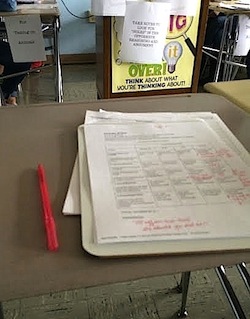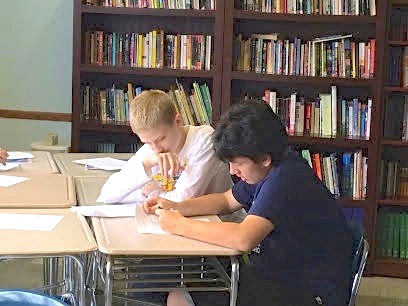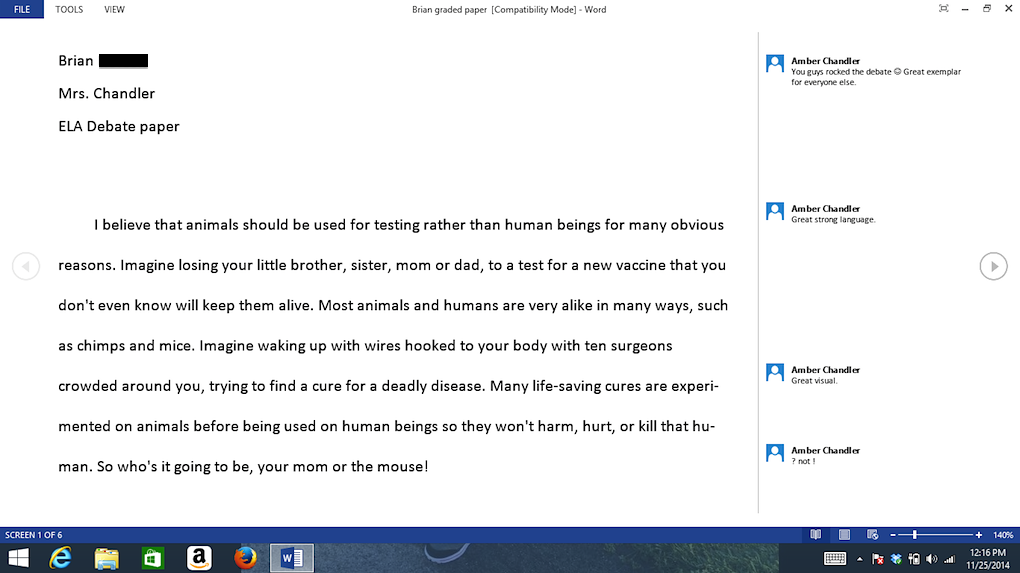Tackling Debate in the Middle Level Classroom
 by Amber Chandler
by Amber Chandler
Years ago, when I was a high school teacher, I loved to stage debates. My juniors would debate the guilt of Hester Prynne when reading The Scarlet Letter and my seniors the necessity of the military draft with The Things They Carried.
When I shifted to teaching middle school 11 years ago, I abandoned debates because I just wasn’t sure the students—or myself, honestly—could handle the multiple layers of preparation necessary for a “live event” that is dependent on research, interdependence of team members, and public speaking skills.
But this year, while reading Flowers for Algernon with my 8th graders, they engaged in a deep conversation that convinced me of two things: (1) debates were definitely doable, and (2) they would be a great way to address Common Core Standards.
The Spark

My students know that every unit ends with a “Show What You Know” of some sort. This usually means a presentation, skit, demonstration, Prezi, or other chance to exhibit knowledge for an authentic audience of peers, parents, grandparents, and administrators.
I always try to provide lots of freedom for students to use their talents, and when Jenna asked, “Could we do a debate?”, I saw that I suddenly had the attention of an entire room of 8th graders, waiting for me to answer the question. I knew that I had to make this happen. Students were begging me to allow them to do the research, work together as team members, and come before a live audience to debate an ethical issue. How could I say no?
The First Steps
The first step was the research piece. The position paper would be the perfect vehicle for students to gather information. Their paper had to address the opposition, so essentially, the position paper became their notes for the debate, though I didn’t frame it that way for them. I thought that trying to prepare for the debate while writing the paper would be too overwhelming, so we took it one step at a time.
Students had to use three sources I provided, and they had to find one resource of their own. Students had to insert their sources as links – a 21st century skill, for sure. Rachel Brew, our Library Media Specialist, collaborated with me and posted the sources on the library website so students could work from home and easily cut and paste links. Here’s the opening paragraph of Brian’s paper (click to enlarge). He provides a good example of an attention-getting introduction. As the paper progressed, he embedded his research sources in his key statements.
Collaboration Time
Once students completed the paper, they spent a few days in their Resource Group (a table of students who work together each quarter), sharing papers and making notecards for the debates.
I specifically wanted them to understand that evidence wins debates – both in speaking and when writing. I showed them several examples of middle school debate videos, emphasizing that this was our first time through.
The format I chose for the debate was a six-minute opening argument from the pro-animal testing side, a four-minute rebuttal from the opposing team, then the response to the rebuttal in 2 minutes, as well as a concluding 2 minutes from the pro-animal testing side. Then, we switched, and the against-animal testing side began with their six minutes and continued in the same way.
This video (above) shows a portion of one of our class debates. Megan is using the resources from our position papers, as well as her additional research, to make the argument that animal testing is necessary.
She is also demonstrating several of the public speaking skills we emphasized: speaking directly to the opponent, repetition, and cataloging of information (particularly numbers) are all areas we specifically discussed. Additionally, she is loud and clear, which is always a concern in public speaking.
The second clip is of Lauren, giving the rebuttal. One of the quietest girls in my class, she has become very comfortable with public speaking.
Appropriate for all students?
Okay, you might concede, a debate works for middle schoolers who already like to participate, but is this really possible for all the students in my class?
I certainly felt nervous about springing this on students who aren’t strong in ELA. However, the resource teacher for my team called me when debates were done and said, “Don’t give this project up, even if it was hard. I admit that halfway through I thought you were nuts. These students did not think they could do this, and when they did, it opened them up to the idea that they can succeed in serious academics.”
It was an affirming phone call that I needed to hear. It’s never going to be all smooth sailing when we take on project based learning and include a public presentation component. For example, one day I had to reschedule a debate because one of the students had a death in the family. Another day we shifted things around because a student was absent. If technology is involved, it will sometimes fail. A student may panic and you will need to make adjustments on the spot. Expect some rough water.
Parent Reactions
Parents felt the “rigor” of the project too. I answered countless emails and fielded several phone calls. I emphasized that the project was developing skills that the Common Core standards emphasize, particularly using evidence to persuade.
The public speaking aspect of the debate worried students and parents the most. Of all the Common Core expectations I can cite, it’s the Speaking and Listening standards that have most supported my teaching. I’ve always incorporated these skills in my lessons, but finally I am backed up by the Standards.
One particular student’s mother was very nervous about her son’s ability to debate, so when I received the following email I was especially pleased: “I just wanted to thank you for allowing us the opportunity to come in and see my son participating in the debate. It meant a lot to see him getting the courage up and speaking in front of the class.”
Feedback and Assessment

However, like most teachers, I live and breathe in a world where grades do matter, so I do my best to honor both ways of “grading.”
The rubric I used is very basic. I wanted each student’s number grade to reflect their overall performance, but also provide more nuanced information. For example, I wanted a student to know that s/he could do very well in the presentation while at the same time understanding that all students have individualized areas where there is room for growth.
Some Lessons Learned
I would judge our first debating effort a success, but hindsight is 20/20 and there are several changes I’d make that I’ll pass on to interested readers.
If you plan to do a debate in a middle level classroom, give yourself even more time than you already think is too much. My biggest mistake was that each debate, when all was said and done, was about 36 minutes long. My classes are 42 minutes. There were days when students ran very close, increasing all of our anxiety.
Another aspect to consider is the size of each debate team. I went with four students, but I think I’d actually make it smaller, with just three. With four students, the teams seemed to divide themselves into pairs, which didn’t create the best teamwork.
Of course, as all teachers know, next year’s group of kids may have completely different needs, so stay tuned for Debates 2.0!
Amber Rain Chandler teaches English Language Arts at Frontier Middle School in Hamburg, NY, a suburb of Buffalo. A certified School Building Leader, Amber also teaches Methods in English Teaching at Medaille College and leads staff development on Differentiation for the Southtown Teachers Center. She blogs at AFT’s Voices from the Classroom and her own website. Follow her on Twitter @msamberchandler.






































Yay! Someone committed to teaching debate. Some resources for the Listening/Speaking standards: goo.gl/ven2jp ; goo.gl/sOrLp ; goo.gl/4iJh1G . Keep up the good work!
I am a debate teacher now, after 22 years of teaching various types of English, mainly at the middle school level. I wish I had known that Texas has competition in debate at the middle school level back when I taught there. Urge your kiddos to explore competitive debate. They can get as far as national events!
Thanks for sharing, Amber! I’ve tackled Socratic Seminar with sixth graders and I think they’re ready for a full-fledged debate. Great template to use as I start thinking of incorporating it into our expedition about the modern food system!
I am a parent of one of the students in Mrs. Chandler’s class and I applaud her for challenging our students. When you get 8th graders to come home talking about a project and excited to work on it, you are really doing something right. I love that Mrs. Chandler involves the students in every aspect of her projects and they truly accomplish great things! They learn through trial and error right with her and they are very proud of their achievements. She encourages each of them to show their own strengths and offers support through every project. She also taught them through this project that everything doesn’t work out perfectly and you need to problem solve to reach your goals. The papers and debates were very impressive!
I agree! Thank you for all your hard work and effort in engaging our children!
This was a very interesting article to read and I commend you for challenging students. I currently work in the banking industry and surprisingly enough public speaking, defending your opinions, solutions, or problems, and research are a huge part of what I do. Students need to learn this skill early on in order to “perfect” it by the time they are out in the real world.
Nice job Brian. I thought you made some very convincing points in your paper. Overall, I liked the idea of challenging these young students. I didn’t come across my first debate until I was in my final year of college and I wish I would have gotten some experience sooner.
Thanks to Amber for taking the risk and teaching our children how great it is to do challenging things. More kudos for sharing the story. I hope your success and lessons learned will inspire others to give more kids this great experience.
Great job to the students who worked very hard on their debates and to Mrs. Chandler. I could tell from reading this piece that she was very proud of her students as she should be. Mrs. Chandler should be recognized for her hard work and dedication. She made learning fun again with much creativity. I never partook in a debate and had a small one in college, but it was not to the extent of this 8th grade class. I wish I had more experience in debating growing up because they have so many advantages for the students especially as they grow up and in the real world.
After reading this, I thought how much of an impact debates can have on the students. Debate activities have a practical and meaningful influence on the students especially from diverse backgrounds and, in particular, on the development of literacy skills. I’m a teacher in a city school that is very diverse and the literacy piece is a main focus of ours. My students have different backgrounds, which leads to very different opinions and viewpoints. Debates would be fun and beneficial to hear the different viewpoints and to also have them work together much like Mrs. Chandlers class. With the different comradery, it would help the students develop better critical thinking, communication, boosting aspirations, confidence, and cultural awareness.
Overall, we want what is best for our students and their future. Broadening horizons, improving cultural awareness, and the empowerment of young people are important elements of the value of debate activities in schools. Keep up the good work!
Bravo! to all the students and Mrs. Chandler. What a great life lesson experience. What a fun way to research, collaborate together, discuss and learn about a real topic.
You all should be very proud!!
You did an amazing job! The kids are lucky to have such a talented educator. Brian Norsen’s paragraph on animals versus people for research was well written. I loved his last sentence: mice or Mom! Fantastic closing!
Suzanne Schmidt
I utilize debate quite a bit in my 6th grade class of humanities. Public speaking, as Erik Palmer also discusses, is a great way for kids to overcome their fears and give a message that they have accomplished something. I use the debate during our Civil War unit, as well as during our unit on Federalist v. Antifederalist positions. I use primary and secondary sources for research first, then have the various sides develop arguments based upon their research, then take on actual characters (fictional) who would be affected by the results of the debate, and then conduct the actual debate. Our periods are 55 minutes, and our class size is approx. 16, which gives us time to complete the debate. Loads of fun for the kids, and the feedback from parents has been truly positive and supportive.